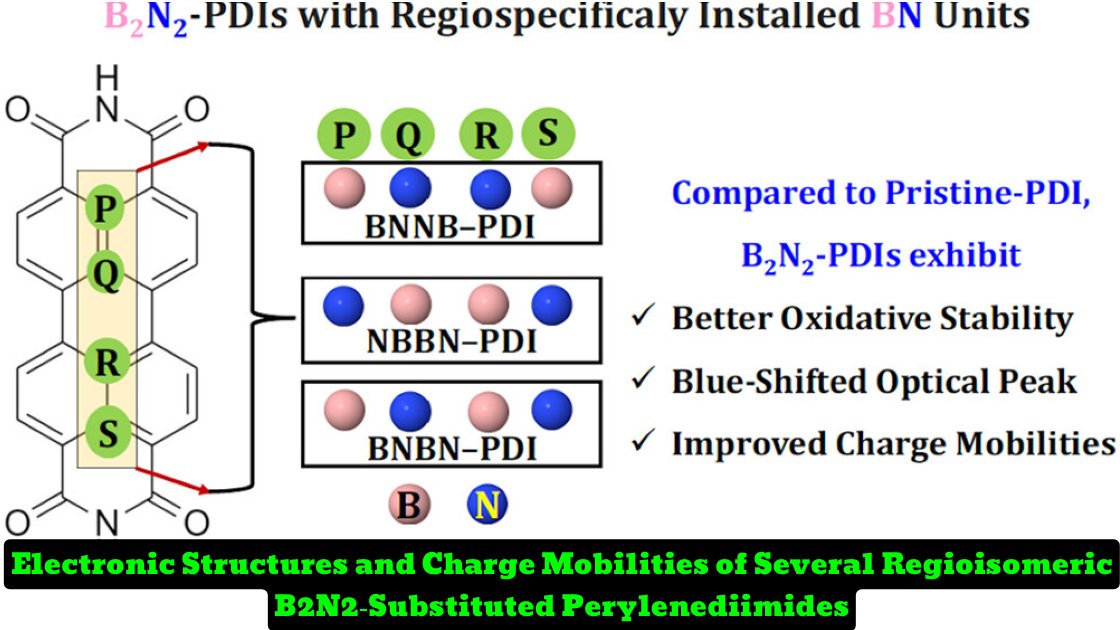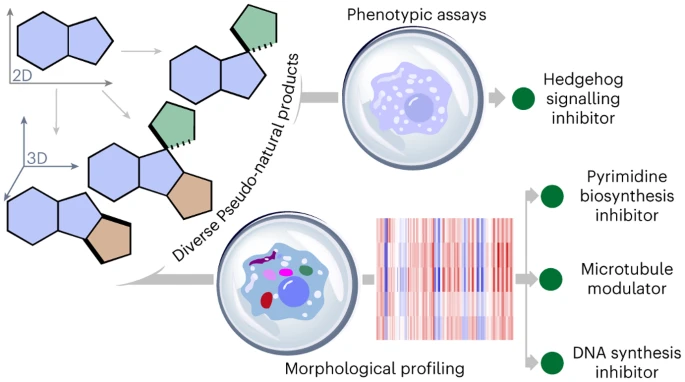Headlines:
- New Study Investigates Electronic Structures and Charge Mobilities of B2N2-Substituted Perylenediimides
- Density Functional Theory (DFT) and Time-Dependent DFT (TDDFT) Used to Study Optical Properties and Transport Properties
- Results Provide Insights into Tailoring Optoelectronic and Charge-Transport Properties of PDI Materials
Outcomes:
- Quantitative analysis reveals an increased electronic gap and blue-shifted optical peak for B2N2-PDIs compared to pristine PDI, in good agreement with experimental observations.
- Different BN-substitution patterns, BNNB and BNBN with zero dipole and BNB with finite dipole, impact the electronic structures and charge mobilities of B2N2-PDIs.
- Large electron mobility (μe) is found for experimentally synthesized BNNB-PDI due to greater Ve and smaller λe, matching field-effect transistor estimates.
- Small hole mobility (μh) and relatively large λh yield greater μh for NBBN-PDI.
- Reorganization energies (λ) and electronic couplings (V) are key factors determining the charge mobilities of B2N2-PDIs.
Bullet Point Summary:
- A recent study investigated the electronic structures, optical properties, and charge mobilities of B2N2-substituted perylenediimides (PDIs) using density functional theory (DFT) and time-dependent DFT (TDDFT).
- Different BN-substitution patterns, BNNB and BNBN with zero dipole and BNB with finite dipole, were considered to understand the impact of BN-substitution on PDI properties.
- Results showed that the presence of BN units caused an increased electronic gap and slightly blue-shifted optical peak compared to pristine PDI, consistent with experimental observations.
- Electron and hole mobilities were calculated considering the most stable dimer structure, and the predicted trend was analyzed in terms of reorganization energies (λ) and electronic couplings (V).
- Experimentally synthesized BNNB-PDI showed large electron mobility (μe) due to greater Ve and smaller λe, while NBBN-PDI showed greater hole mobility (μh) due to smaller λh and relatively large Vh.
A recent study conducted by Ahmed and Manna in 2023 investigated the electronic structures, optical properties, and charge mobilities of B2N2-substituted perylenediimides (PDIs) using density functional theory (DFT) and time-dependent DFT (TDDFT) methods [1]. The study aimed to explore the impact of BN-substitution on the electronic properties and charge transport behavior of PDIs, which are widely used in various optoelectronic devices.
The researchers considered a few isoelectronic B2N2-PDIs with varied BN-substitution patterns, namely, BNNB and BNBN with zero dipole and BNB with finite dipole, and studied their electronic structures and spectroscopic properties. The calculated results showed that the presence of installed BN units caused an increased electronic gap between the highest occupied molecular orbital (HOMO) and lowest unoccupied molecular orbital (LUMO), resulting in a slightly blue-shifted low-lying optical peak compared to pristine PDI. This finding was in good agreement with the reported experimental observations.
Electronic Structures and Charge Mobilities of Several Regioisomeric B2N2‑Substituted Perylenediimides
Ahmed; Manna 2023
Full text link: https://doi.org/10.1021/acs.jpca.2c09106
Help us improve! Select the sentence(s) if helpful, and click on “send feedback” below.
What this paper is about
- Here, it is interesting to note that the bright * state corresponding to the HOMO LUMO transition for all of the B 2 N -PDIs is blue-shifted by 0.2 to 0.3 eV as compared to the pristine PDI vertical excitation energy of 2.64 eV in DCM. This is well consistent with the differences in E HL between B 2 N -PDI and pristine one as discussed above.
- Calculated E 0 values for the bright * state are found to be similar for all three B 2 N -PDIs.
- Similar to pristine PDI, 12 the calculated h is much smaller than the e for each of the studied three B 2 N -PDIs. This resulted from the larger displacements projected onto the in-plane normal modes for electron injection than holes as revealed by the Huang Rhys factor analysis implemented using the DUSHIN code.
What you can learn
- Quantitatively, an increased gap by 0.03 eV between the LUMO and LUMO + 1 and 0.28 eV between the HOMO and HOMO 1 is found for the 6-EH crystal dimer.
- In contrast to this, the opposite B 2 N 2 pattern, i.e., NBBN-PDI, shows much improved h as compared to e due to larger V h and significantly smaller h. Comparatively much smaller e and h are found for the BNBN-PDI due to relatively large and small V. We note that the calculated e for the B 2 N -PDIs are slightly larger than those reported for the pristine PDI.
- Depending on the BN-substitution, slightly varied charge mobilities are predicted for B 2 N -PDIs, which is mainly due to differences in V. Importantly, large e is found for experimentally synthesized BNNB-PDI due to greater V e and relatively smaller e matching the computed value reasonably well with the field-effect transistor estimate.
Core Q&A related to this research
Q:What is the focus of the paper “Electronic Structures and Charge Mobilities of Several Regioisomeric B2N2‑Substituted Perylenediimides” by Ahmed and Manna?
Answer: The focus of the paper is to study the electronic structures, optical properties, and transport properties of a few isoelectronic B2N2-PDIs with varied functional groups at the imide-N positions using density functional theory (DFT) and time-dependent DFT (TDDFT).
Q:How does the presence of installed BN units affect the electronic gap of the B2N2-PDIs and their low-lying optical peak?
Answer: The presence of installed BN units causes an increased electronic gap due to the charge localization, which results in a slightly blue-shifted low-lying optical peak compared to the pristine PDI.
Q:What is the relationship between the charge mobility of the B2N2-PDIs and their reorganization energies and electronic couplings?
Answer: The charge mobility of the B2N2-PDIs is predicted based on their reorganization energies and electronic couplings, which are dependent on the BN-substitution. Larger μe is found for experimentally synthesized BNNB-PDI due to greater Ve and relatively smaller λe, while smaller λh and relatively large Vh yield greater μh for the NBBN-PDI.
Q:How were the Franck-Condon geometries in DCM obtained in the study?
Answer: The solvated Franck-Condon geometries in DCM were obtained using the same OT-RSH functional within the Tamm-Dancoff approximation (TDA) of TDDFT for the first singlet S1 and also the first low-lying triplet Tn (n = 1-3) excited states to overcome the well-known triplet instability.
Q:What is the potential significance of the results obtained in the study?
Answer: The results obtained in the study may help to understand the reported experimental observations and also to develop related functional DPI-based electronic materials for applications in advanced electrical and optical devices.
Basic Q&A related to this research
- What are electronic structures?
A: Electronic structures refer to the arrangement of electrons in an atom, molecule, or material. The electronic structure plays a vital role in determining the chemical and physical properties of a substance.
- What is charge mobility?
A: Charge mobility is a measure of how quickly and efficiently charges can move through a material. High charge mobility is essential for efficient electronic devices such as transistors.
- What are B2N2-substituted perylenediimides?
A: B2N2-substituted perylenediimides are a type of organic molecule that can be used in electronic devices due to their high charge mobility and other desirable properties.
- What is DFT?
A: DFT stands for density functional theory, which is a computational method used to calculate the electronic structure and properties of materials.
- What is TDDFT?
A: TDDFT stands for time-dependent density functional theory, which is an extension of DFT that allows for the calculation of excited state properties such as optical spectra.
- What is OT-RSH?
A: OT-RSH is a specific implementation of DFT that includes the treatment of vdW interactions, which are important for the accurate prediction of the properties of condensed phase materials.
- What are spectroscopic properties?
A: Spectroscopic properties refer to the interaction of light with matter and the resulting effects on the electronic and molecular structure of the material. These properties can be measured using techniques such as UV-Vis, infrared, and Raman spectroscopy.
- What is the electronic gap?
A: The electronic gap is the energy difference between the highest occupied molecular orbital (HOMO) and the lowest unoccupied molecular orbital (LUMO) in a molecule or material. It is an important parameter for understanding the electronic and optical properties of a material.
- What is charge localization?
A: Charge localization refers to the degree to which electrons are confined to a specific region or atom in a molecule or material. This property can influence charge transport and other electronic properties.
- What is an optical peak?
A: An optical peak refers to a characteristic feature in the optical spectrum of a material, which corresponds to the absorption or emission of light at a specific energy.
- What is a dipole?
A: A dipole is a separation of electric charge resulting in a positive charge on one end of a molecule or material and a negative charge on the other end. Dipoles play an important role in a variety of chemical and physical processes.
- What is vdW interaction?
A: vdW interaction refers to the van der Waals interaction between atoms or molecules that arise due to fluctuations in their electron densities. vdW interactions play a critical role in the properties of condensed phase materials.
- What is a field-effect transistor?
A: A field-effect transistor (FET) is a type of transistor that uses an electric field to control the flow of charges through the device. FETs are important components in modern electronic devices such as computer processors.
- What are transport properties?
A: Transport properties refer to the behavior of charges, heat, or other quantities as they move through a material. Understanding transport properties is critical for the design and optimization of electronic and other advanced devices.
- What are imide-N positions?
A: Imide-N positions refer to the locations of nitrogen atoms in the imide functional group, which is found in many organic molecules. The position of the imide-N atoms can have a significant impact on the electronic and physical properties of the molecule.
- What is Franck-Condon geometry?
A: Franck-Condon geometry refers to the geometric configuration of the molecule or material in the ground state before and after electronic excitation occurs. The Franck-Condon principle plays an important role in understanding the properties of excited states in molecules.




